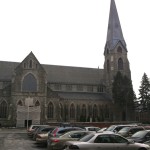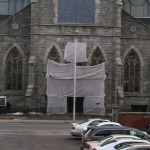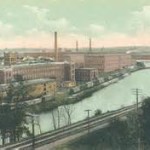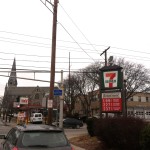For a girl who grew up without the regular back and forth to any house of worship, I sure do have a pretty good knack for getting really close to churches in my adult life. And the strange thing is, I haven’t even tried. It’s almost as if they found me.
I’ve just started a new chapter of proximity, and this time around I’m struck by how the very different elements of tremendous weight and airy spirituality combine in the religious realm. Think about it:
 the buildings are often so massive, in a completely rock-solid sort of way. Matters of the soul, on the other hand, have a kind of misty, elusive quality to them. At least mine do. You’re this way—no wait, you’re that way. This reality is actually pretty far out, but we’ve learned to take it almost for granted.
the buildings are often so massive, in a completely rock-solid sort of way. Matters of the soul, on the other hand, have a kind of misty, elusive quality to them. At least mine do. You’re this way—no wait, you’re that way. This reality is actually pretty far out, but we’ve learned to take it almost for granted.
In a way, it makes perfect sense that my new job at a Catholic school in Lawrence, Massachusetts is located directly across the street from an enormous Catholic church. I mean, why wouldn’t the Sisters of Notre Dame have settled here, among many other far-flung places around the world, to do their good works? Plus, on a more personal level, maybe I can get some inkling of what my husband is dealing with in his work, particularly when it comes to the very real matters of real estate and building maintenance. In case you haven’t been married to a member of the clergy recently, you may not know that in fact large structures have a way of becoming a big part of spiritual life. This is just the kind of thing that’s pretty fascinating to someone like me, trying to get a good grasp (maybe that’s paradoxical in itself) of how the ethereal and the completely solid can interact.
St. Mary of the Assumption looks more like a cathedral, or maybe even a fortress, than a regular old church. The steeple rises over the city prominently, and the bells – the only full chime of 16 in Massachusetts — ring out as they have done for a century and a half. But the place also has a kind of somber, forbidding look; sections of the church are draped in huge pieces of cloth, evidence of ongoing renovations, and only the small chapel is open during the week. I’ve yet to see any workers over there; then again, it is steely January now.

If the place could talk, it would definitely say something like, “Immigration? Let me tell you about it, in waves, starting with the Irish. Mill workers? Have I got stories for you.” Their website, where I eagerly went to lap up any background I could find, has a long section on history which, like the church itself, is “under construction.” We’re taken through a winding story up to the early 20th century and no further. Whoever was writing it must have gotten exhausted, honestly, because the 19th century was bulging with so many details: this priest who did these remarkable things and started the parish at such-and-such location was followed by the next one who did even more remarkable things on the next site, etc. Here’s how the article begins:
The history of St. Mary of the Assumption parish developed alongside the history of Lawrence, Massachusetts. The thousands of immigrants who came to the New World in search of freedom, opportunity and a safe environment for their families also search for a church to worship their Creator.
Notice here how “search” is in the present tense; maybe that was a slip, or maybe not, because people are always and forever searching. I can’t tell you exactly the order in which groups of people came (the Irish and the Italians were early arrivals), but Dominicans—that is, people from the Dominican Republic– make up the majority of Lawrence’s population now. Unlike the Europeans, they have had to find employment in industries other than textile manufacturing. The once-booming mills are now dormant or converted to other uses. These buildings, too, could speak volumes.

But back to church history.
Archbishop John J. Williams solemnly dedicated the new St. Mary Church on September 3, 1871. Its statistics are still impressive. St. Mary Church cost over $200,000,00 to construct. It is of Gothic style architecture and it is constructed of granite brought from the quarries of Maine and New Hampshire. The dimensions of the Church are like a cathedral: The length of the building along Haverhill Street is 210 feet; it is 80 feet wide, except at transept where it is 102 feet wide. The steeple is 225 feet high. The tope (sic) of the Cross which surmounts it is 235 feet from the ground which makes it fifteen feet higher than the Bunker Hill Monument.
Solid? Definitely. Intimidating even? Yes. Elevating to the spirit? Absolutely. Needing constant maintenance at daunting costs? Well, that too.
I’m told that services are still well-attended on Sundays, with families pouring in, and I’m looking forward to going when there’s an all-school mass over there in February.

In the meantime, when I pass the 7/11 on the way back from the Post Office, this will be my view, reminding me that maybe it’s precisely that strange combination of heft and history with angels and whispering prayers floating in the air that gives this church its staying power. The future only knows how it will indeed stay.
